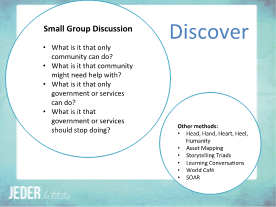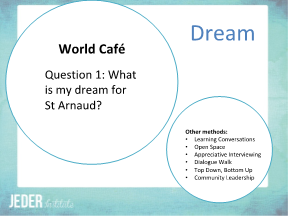
State or Province:
country:
what are your gifts and talents?:
why do you want to join abcd in action?:
An Overview of Conscious Co-Design
An Overview of Conscious Co-Design by Dee Brooks
Based on reflections of the concept of The Natural and the Open from The Apparatus, by Giorgio Agamben
The overview of Conscious Co-Design (CCD) offers a space for inquiry and conscious decision making when practically applying a number of community engagement and development frameworks, including their practices, processes, patterns and guiding principles. It is loosely based on the work of Giorgio Agamben’s “What is an Apparatus?” and other essays, 2009, who states,
“I will call an apparatus, literally anything that has in some way the capacity to capture, orient, determine, intercept, model, control, or secure the gestures, behaviors, opinions, or discourses of living beings.”
ABCD, Appreciative Inquiry, Place Making, Art of Hosting, Collective Impact, Timebanking, IAP2, Person-Centred Thinking and many more, all have elements in common. They are all one language of a larger movement and the practitioners who apply them are all striving to make the world a better place yet, they are often pitted against each other in unhealthy and unnecessary competition!
By intentionally inviting key stakeholders and those directly affected by the challenge, issue or concern into conversation, we create a core team, who are committed to the work, and who will respond because they care enough to act. This also responds to the principle of not working alone and inviting a diverse group of voices into the conversations. A very broad example of CCD might be:
- Patterns such as DEC Thinking (the Breath Pattern) or Theory U, both found in the Art of Hosting practices, offer the organic nature of a pattern to explore
- Methodologies like Narrative Therapy and Appreciative Inquiry offer the evidence-based dialogical framework to support purposeful divergence
- Movements like ABCD, Placemaking, Timebanking or Collective Impact provide the vehicle for engagement and development for convergence
Conscious Co-design in Action
Consciously co-creating participatory design processes “with” community not “for” community.

Collective Purpose: What does intention look like in practice?
Purpose and intent is central to this thinking. What are you aiming to achieve? Who wants this? Who cares? Who are the key stakeholders? What are your principles of working together? How will you sense in to what is being longed for?
Focusing attention on the community-led aspect of this work is paramount here, as the answer does not lie in what a group of practitioners and/or community workers think or decide to do. Community conversations, offering deep dialogue, are a key component of discovering purpose and there is a multitude of ways to discover this through learning conversations, as can be found in the Art of Participatory Community Building Guidebook. Once the collective purpose is identified, a pattern will start to emerge and it’s important to remember that meaningful work takes time!
The Common Elements
It’s important here that you enter with a curious mind and stay open to the possibilities of blending practices and processes. This takes time and is a practice within itself.

Patterns – locating Self and others:
A pattern is a recurring characteristic, which helps identify past, present, future movement of rhythms.
- What underlying pattern might support your next wise steps? Is there a broader picture or systems view of the issue, challenge or project to explore?
Practices – living more consciously each day:
A foundational form undertaken with the aim to improve.
- What practices will best serve your purpose? Are there daily or regular patterns that will keep you on track or support your movement through the patterns?
Processes – shifting from A to B:
The steps taken to achieve an outcome or activity.
- Which process will best serve the action required? What are the most relevant and appropriate processes that will shift your work, community, organisation or system into generative action?
Principles – the values that hold us in place:
Identifiers and the foundational building blocks of good practice.
- What are the principles that encompass your purpose? What are your values and the values of the organisation, family and community? What drives your choices, passion and ways forward?
A step through example:
Let’s imagine that a local government authority is developing their ageing strategy and would like to map the needs of older people in their community and look for solutions to include in their 2025 visioning strategy.
First, let’s break that down and see what they’re looking for:
- Older people
- Their needs
- Solutions
Nothing about us, without us!
If we look back to the first suggested steps of CCD, we want to discover the purpose for doing this and develop a statement like, “how do we discover older people’s needs?”
The organisational purpose is that the local authority requires the outcomes to respond to legislation but what is underneath that? Have we spoken to older people? What do we want to ask them? Who else cares about this? Why is this important? What might happen if we ask older people about their needs? How would they feel? Can we do anything with a need?
Positive Core and The Power of Questions
Using Appreciative Inquiry, let’s take the statement, “how do we discover older people’s needs?” and look at reframing the statement into an invitation. We want to create a positive core. How do we reframe this? What’s a positive core process? What makes questions inspiring, motivating and energising?
By putting community members, their skills and abilities at the centre of the statement and inquiring with the key stakeholders with an open and curious mind, we will discover how they feel about the situation, what they have to offer and how they might approach the topic themselves.
By choosing the positive as the focus of inquiry, we can discover a stronger calling question or invitation and decide, with the community, which framework would best suit what we now know.
By asking the right questions, we could now have a stronger invitation or calling like, “how do we discover the strengths of older people to contribute to a thriving future?” where we could now apply ABCD and asset mapping as the community-led strategy to diverge and discover individual, community and organisational assets and Art of Hosting processes for the divergent conversations in a Collective Impact framework for multi stakeholder action!
A real life example:
In 2019, a local government authority invited the Jeder Institute to deliver some community-based training and host a community conversation to develop the future story of the town. Over many months, we offered the community-based training opportunities, which created the conditions to turn tools into conversations for action by putting community at the centre.
Starting with a strengths-based lens, we first invited local community members to 3 immersive training sessions. For the first sessions, we started with the Breath Pattern, as we discovered the strengths and assets already in the community and explored both the challenges and opportunities for the region. The pattern needed to remain flexible as the community members starting working together between each training session and returning to the next session with concrete outcomes, new neighbours and more questions.

For the culminating community visioning day, the Core Team explored the patterns and we decided on the 5D Cycle of Appreciative Inquiry, (a circular, flexible pattern) to guide us but we were also prepared to change to a number of other practices and processes if required as can be seen in the smaller circles on the slides. Note: there are 2 Dream slides as we used 2 Appreciative Inquiry style questions for 2 rounds of World Café.
By the end of the visioning day, and in addition to the work which had been undertaken by community during the training sessions, the community co-developed 6 strong community-led projects for action!
As our good friend, Mike Green, from ABCD for Inclusion in Denver, USA says, “ABCD is just one language of a larger movement” so, even though CCD is underpinned by ABCD as Jeder’s choice of framework, the Conscious Co-Design patterns, principles, practices and processes thinking still apply in our everyday grassroots work.
Some strategies to start with might be:
- Build, nurture, maintain relationships – it takes time to build trust
- Be authentic and transparent – let community members know the framework you’re thinking might suit them, have the discussion
- Identify community leaders – they have existing, strong networks and are not always the usual suspects
- Listen deeply and ask wisely – whenever and wherever possible
- Whenever possible, practice the art of reframing – shift the language from needs to strengths
- Host conversations – experiment with asset mapping, learning conversations, story, World Café, Open Space or any other participatory method which aligns to your purpose
There is no correct way of doing this; each community is unique and will be guided by the individual capacities, community strengths and organisational resources and networks that are present. Be open and honest about your own intention. Be authentic and ethical and walk your talk. Above all, be present and invite community to the centre from the very beginning.
Originally posted on the Jeder Institute's website blog






